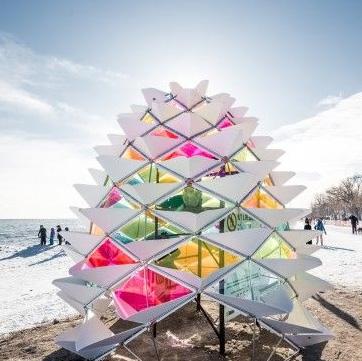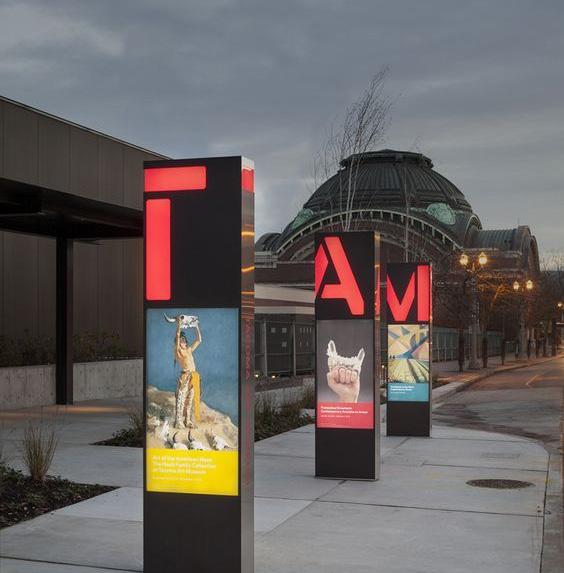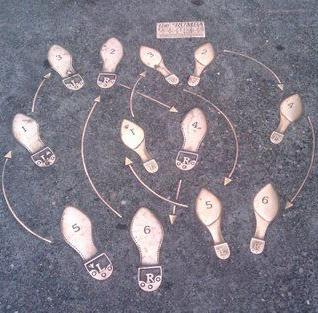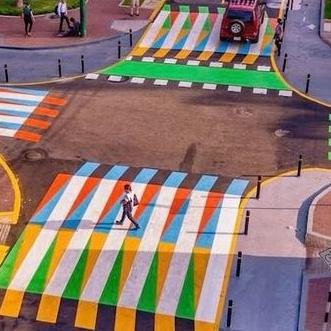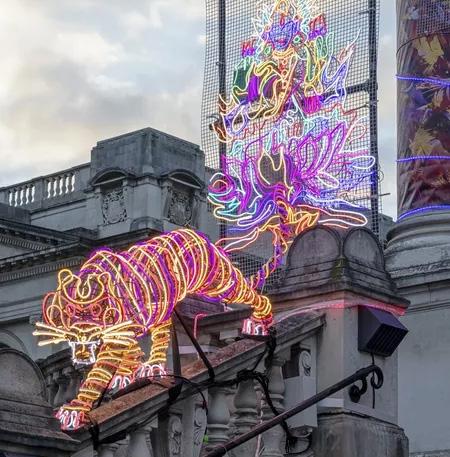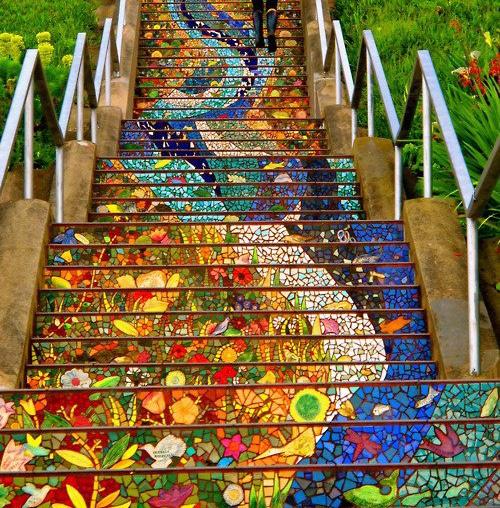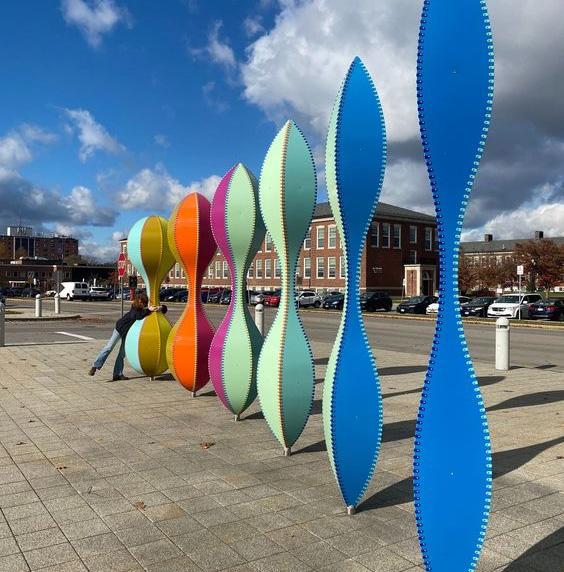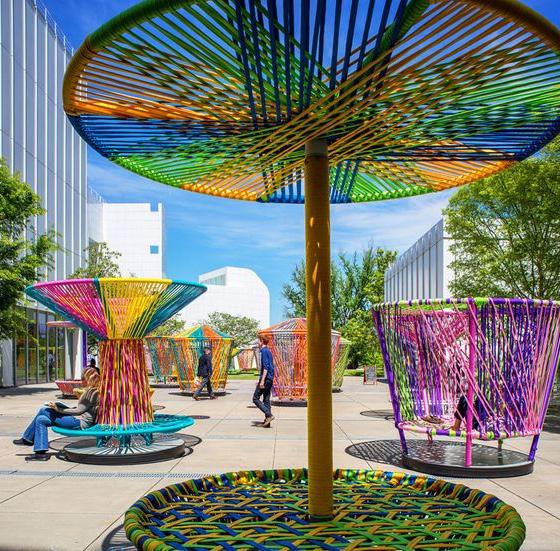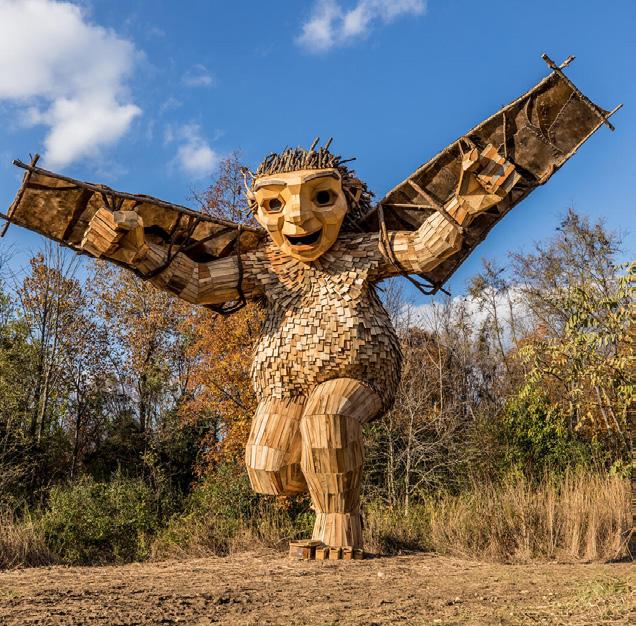





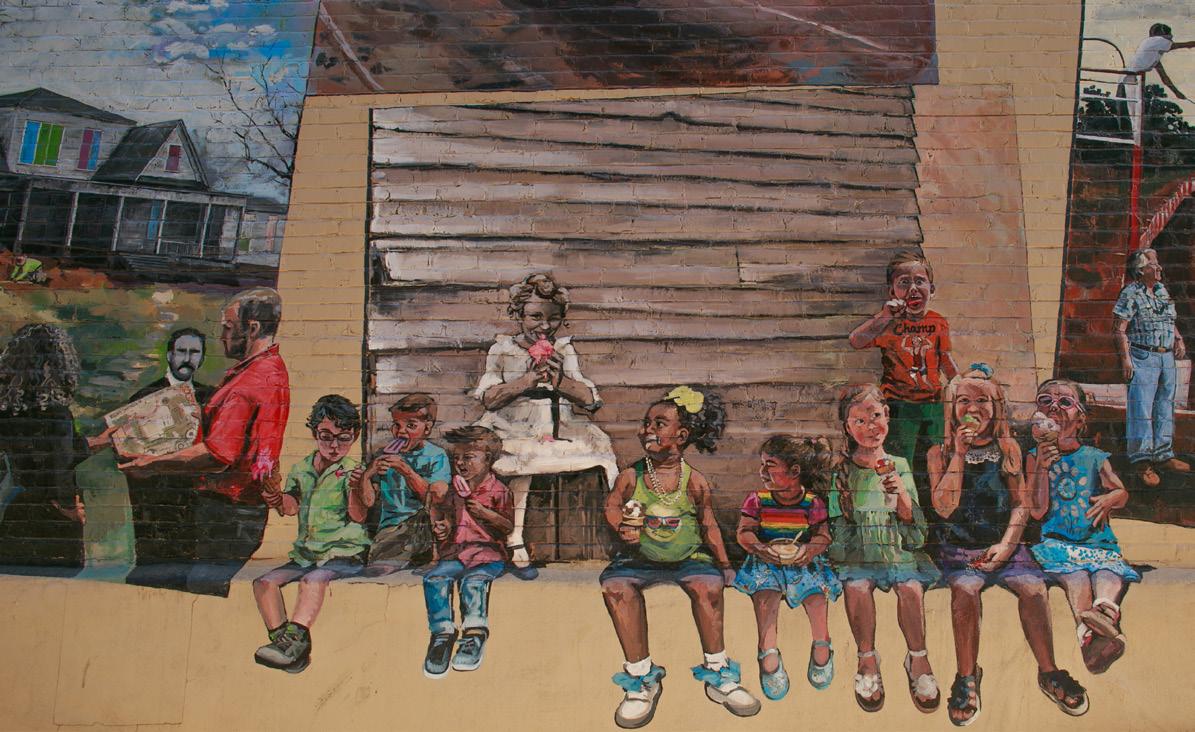
This plan was created in collaboration with the City of Woodstock, the Woodstock Public Art Plan Steering Committee, and Designing Local, who engaged residents and visitors in conversations about public art and the role it will play Woodstock’s future. Insights from these conversations are outlined herein.
ABOUT
INTRODUCTION
WHAT IS PUBLIC ART? WHY IS IT IMPORTANT?
HOW SHOULD PUBLIC ART LIVE IN WOODSTOCK?
PROJECTS FOR IMPLEMENTATION
POTENTIAL COST MATRIX
page 3
page 6
page 20
page 26
page 36
page 66
“Great things happen in amazing places when the arts are center stage....
Every great civilization and impactful era in human history has been paired with a thriving arts presence. As we chart forward a path for a bold, authentic, collaborative City of Woodstock to hand down to our next generation, we recognize that this vision of our future is inseparable from a City that prizes artistic expression and vibrancy.
This Public Art Program is the product of community involvement, stakeholder feedback and most importantly serves as a reflection of the arts-engagement our residents and visitors desire to see continued here in our City.
Art doesn’t happen in a vacuum. It’s a response to its environment. We live in a community hungry for expression, and we have a 127 year old story that is just starting to unfold. The next great chapter in our City’s story comes with a dedicated vision and a plan to gift future generations with more Public Art. Thank you for taking an interest in and contributing to this future for our City today and for generations to com
MAYOR MICHAEL CALDWELL


“Public art humanizes the built environment. It invigorates and transforms public spaces, turning the mundane into the extraordinary.”
Public art acts as the storyteller of the city, bringing elements of broader public identity into physical spaces throughout the fabric of a place. In Woodstock, public art has the opportunity to capture public sentiments and community themes by bringing them into more compelling forms through artistic expression. Through public art, Woodstock can honor city history, values, and identity in a way that enhances and creates vibrancy for its residents and visitors.
- Betty Willis, designer of the “Welcome to Las Vegas” sign
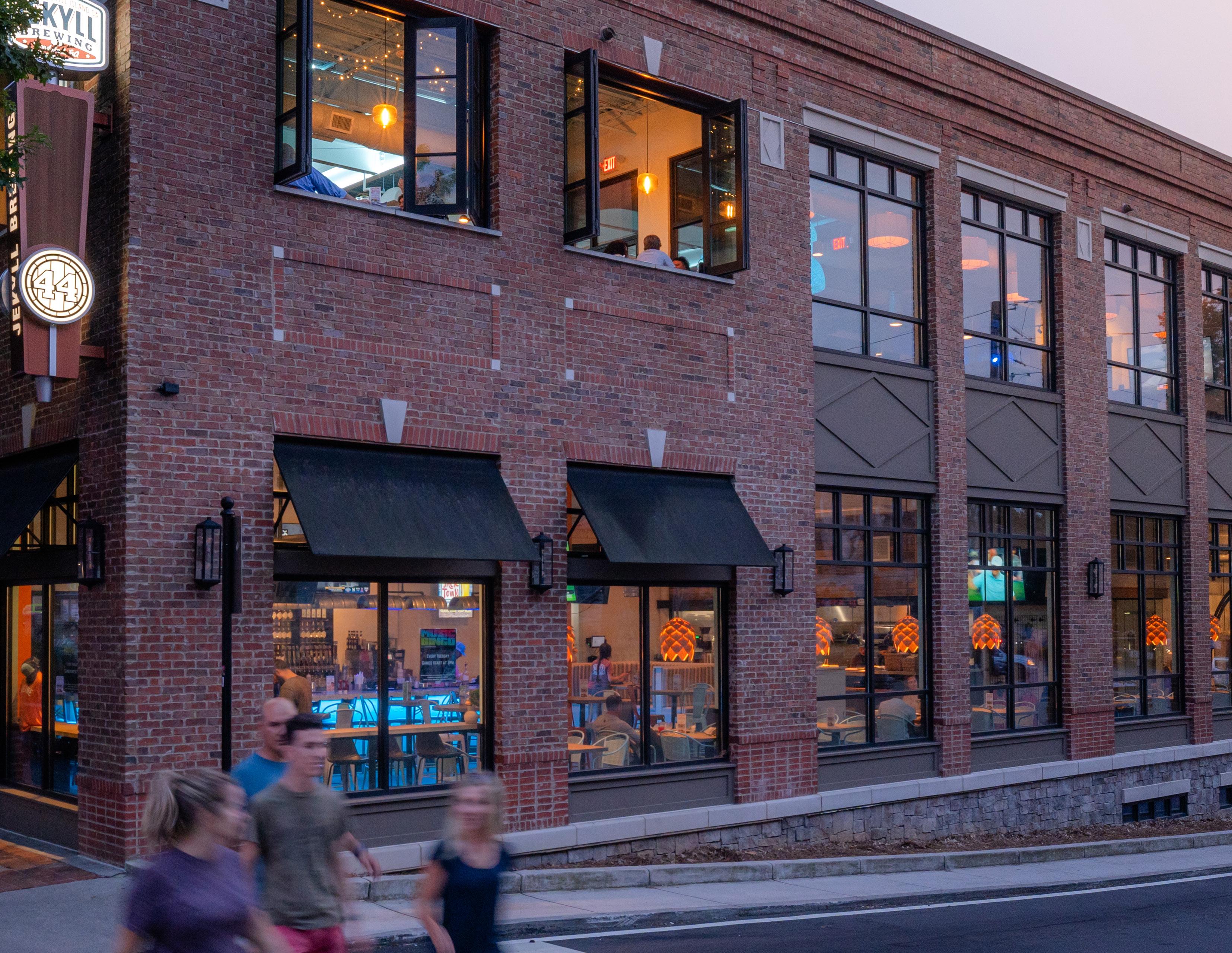
Beyond its visual impacts, public art strengthens the local economy by drawing attention to under-utilized spaces, develops a sense of identity that attracts tourism and residents, and directly supports the local arts economy. Public art in Woodstock has the potential to transform the everyday city fabric into well-loved and cherished public and private spaces.
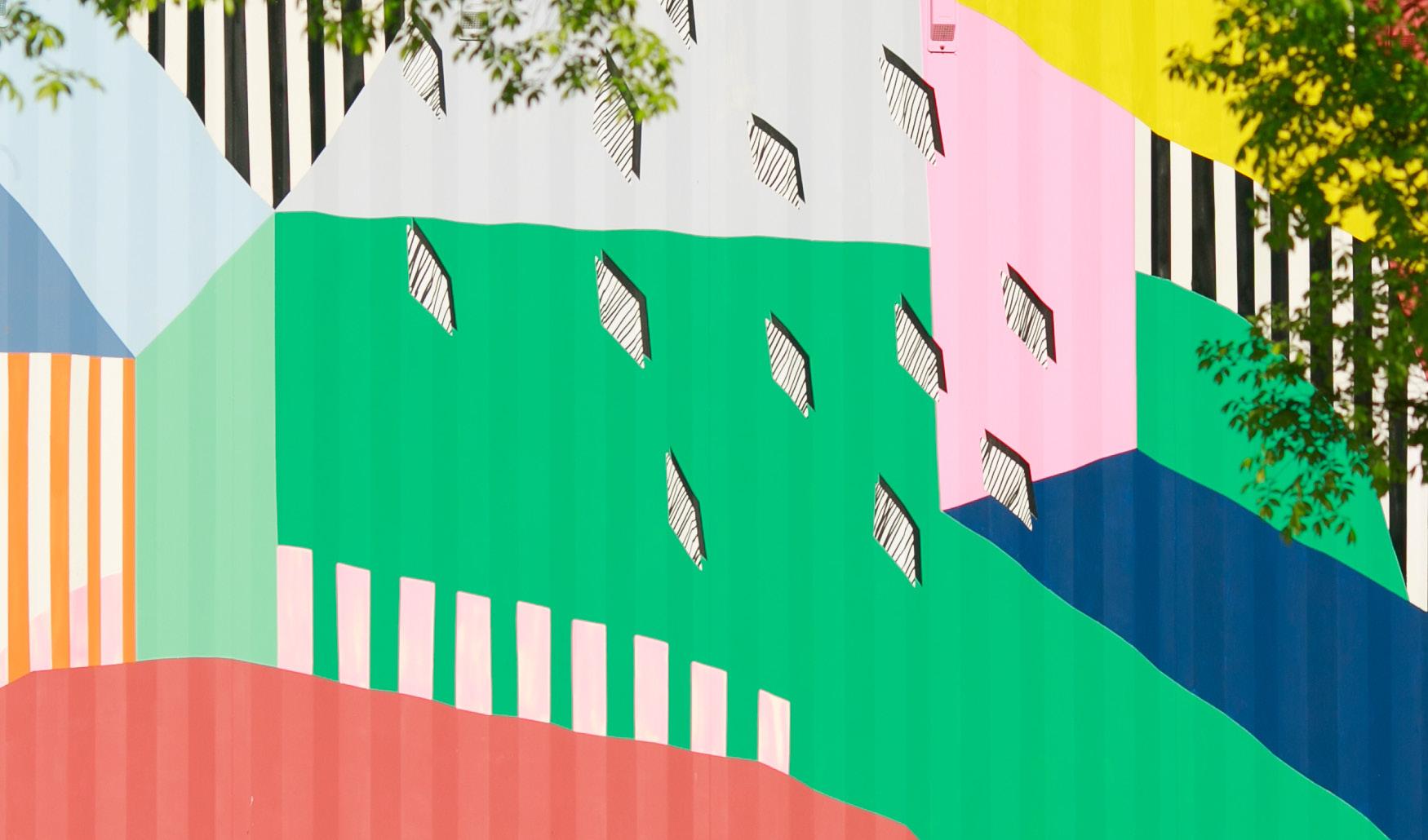
Over the past decade, Woodstock has made tremendous progress in developing a city-wide collection of public art. Recognized widely for its downtown and distinctive approach to planning and development, Woodstock is uniquely positioned to utilize public art to further cement itself as a great place to live, work, and play.
By formalizing a city-run public art program, Woodstock will be able to recommit to its focus on arts and culture as a method for furthering economic development, as outlined in the 2018 Economic Development Plan adopted by City Council. This Public Art Plan is a fulfillment of the vision to establish a public art program as part of the 2018 plan. The public art program will also serve to strengthen the relationship between the city and organizations such as Visit Woodstock GA and Woodstock Arts, both unique drivers of Woodstock’s high quality of life.
Finally, the public art program will assist the City of Woodstock in understanding and navigating a growing arts space and visual identity, providing guidance on administration, policy, and procedures, and ultimately a suite of ideas that will catapult the city into the next phase of its public art journey.




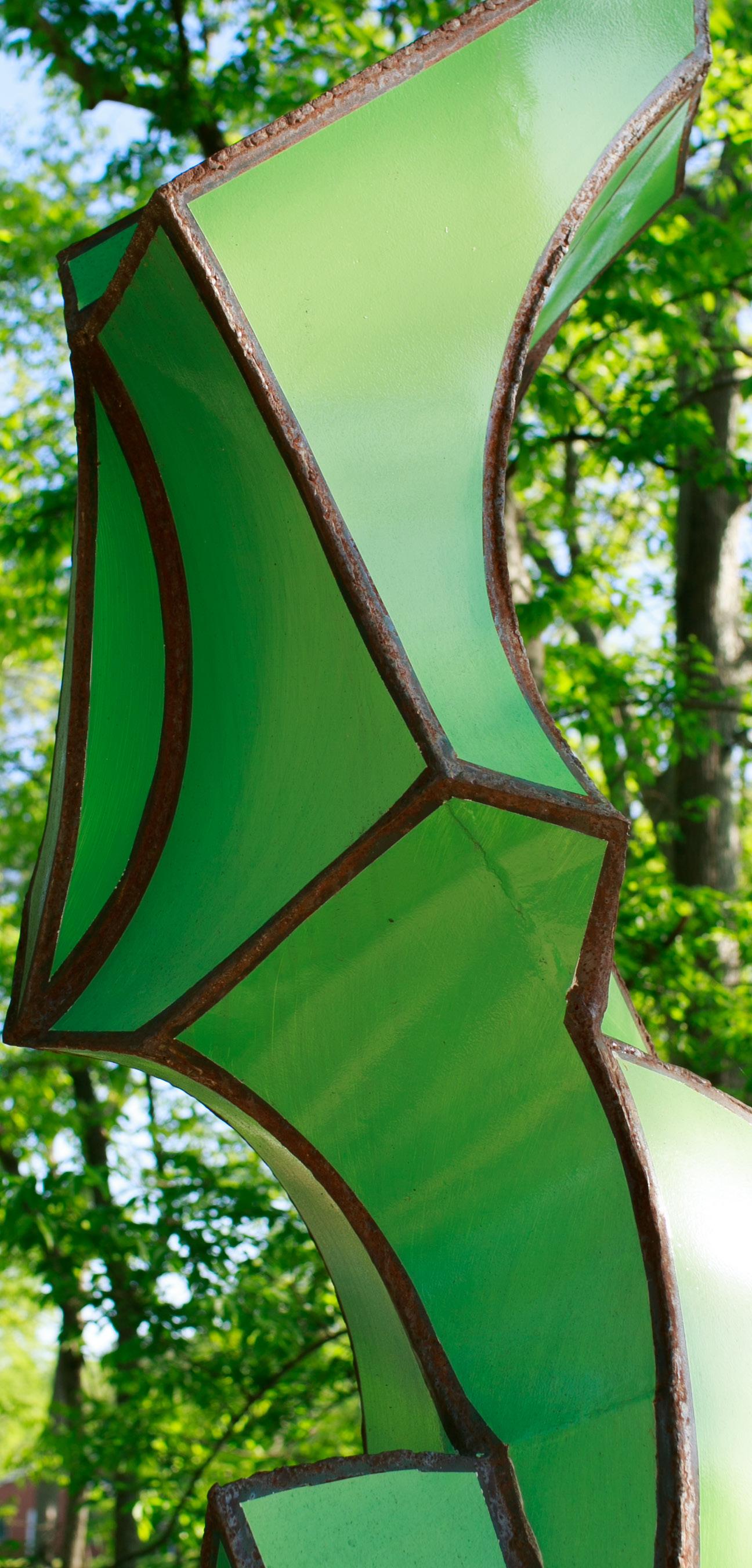
Woodstock is a vibrant community with a love of its natural scenery, a lively downtown, and a strong sense of community pride. Residents feel that a vibrant arts identity lies just beneath the surface, waiting to tell the story of Woodstock to community members and visitors alike through the implementation of wide-ranging public art program.
The Woodstock Public Art Program envisions a vibrant and enriching public art landscape that reflects the city’s unique heritage, values, and aspirations. Through a collaborative process that empowers artists, engages residents, and celebrates diverse perspectives, Woodstock’s Public Art Program aims to transform public spaces into captivating places that inspire, connect, and elevate the Woodstock experience.

Throughout the process of developing this plan, more than 400 residents participated in a digital survey regarding the future of public art in Woodstock, 14 stakeholders were interviewed, and 10 people participated as steering committee members. Beyond these direct engagement measures, individuals were approached during targeted events, such as a Public Art Happy Hour, and wellloved classics, such as the existing summer parks programming, summer concert series, and farmers markets. The following is a snapshot of survey responses.
q1. WHERE WOULD YOU LIKE TO SEE MORE PUBLIC ART IN WOODSTOCK? (SELECT ALL THAT APPLY)


q2. DO YOU HAVE ANY THEMATIC IDEAS ABOUT PUBLIC ART IN WOODSTOCK? (E.G., NATURE, HISTORY, FUNCTIONAL, ETC.?) (SELECT RESPONSES)
• Community
• History, train stop in Woodstock
• Nature
• Nature- would love to be known for the beautiful colors of flowers and tree every season
• We are near the foothills so nature would be great
• Water feature
• Nature

• Charming downtown. Needs new sidewalks and more parking. ( See Greenville South Carolina)
• Breweries, nature
• The nature opportunities with hiking and trails.
• Safety and walkability
• The people
• Families. Very family friendly!
• The support and values
• The people
• Kids play areas.
We need more of them!
• Not sure
• Walkability
• Safety, Affordability, Cleanliness, Natural Beauty Here
• Friendly
• Ability to participate in activities near where you live
• The small town feel
• Safety
• Diversity
• Open minded and friendly
• To be continued
• Cuisines option
• The sense of home, safety, natural beauty, and vibrancy
• The sense of togetherness, community spirit!
• The community as a whole
• Local diversity
• Beauty
• Small town feel
• Community spirit
• The people
• The arts
• diversity and history
• Being a community, the one Ness, events, coming together, safety
• I love our eat, play, work, live here motto. And that we incorporate nature in all.
• Walkability
• The places i am
• Mix of old and new and development
• I love being outdoors, in nature with our whole family and pets.
• Access to beautiful art and music
for kids
• Inclusivity
• Lots of color!!
• History
• Art revolving around our wildlife here!
• Cherokee county art teachers work on display
• Black Art
• Graffiti/painted art
• History
• Native georgia animals and plants
• Water splash area
• Art that blends into nature (ex flower art, using recycled materials, about protecting local wildlife)
• Nature
• Nature
• Local beauty photography or paintings
• Family connection
• Honoring or created by native Americans who lived here first
• Anything of beauty
• Nature
• Nature
• Music
• Murals with nature
• People
• Nature
• Nature
• nature
• History
• I like the hippie theme like the guitar (blue frog stuff) reeves Amphitheater?
• Local artists
• Steampunk
• Nature
• mosaics added to sidewalks, retaining walls, any
• Music
• Functional for the green print like benches or cool shade sculptures
• Trains/railroads
• Timeless art
• continue the musical theme
• Pop art: big feature that individuals can interact with (ex. Sit on)
• Cool splash pad with sculpture type art
• Nature
• Nature
• Nature
• Interactive splash fountain
• Nature
• Black History/

• Family orientated
• Walkability
• Friendliness and the activities and walkability
• Safety and nature
• Walking
• The kind people, family values, clean and safe
• Diversity
• The walkability of our community!!!
• Connectivity; people “champion” one another
• Nature
• Small town vibe
• The unique

• The history of old downtown Woodstock.
• It’s not just shops and restaurants - there are walking trails, Art galleries and art classes, music venues. I’d like the artsy cultural vibe to be emphasized more.
• History
• We love the outdoors, our families and doggies, our health, and live music
• That Woodstock is family friendly not
just a place to come and drink
• In Woodstock you can just be yourself!
• Strong commitment to helping each other flourish
• That we celebrate inclusivity
• We are a fun vibrant community
• I want to embody where mountains meets METRO. We are a thriving small community with every amenity imaginable in the
beautiful mountains of N GA.
• There are Black people here and we need representation.
• Diversity
• That many are open minded (not everybody, but we are trying to grow in a positive direction)
• Woodstock has an wonderful arts community. I know so many residents who have not yet visited Reeves House or seen a play. We have
introduced several friends to these options and they have been delighted.
• We are a community
• Sense of small town joy, family, unity
• Its a great lil art town
• That woodstock welcome all people of any race or gender.
• That there will be enough parking!
• Family friendly
• A community supported by the community
• That we love and
protect our children, they are our future
• More diversity than people think
• That we are culturally diverse and more inclusive
• Were open minded and educated
• How creative we are
• There is a deep Black History in Woodstock, and it’s currently diverse. Programming and downtown events don’t reflect that.


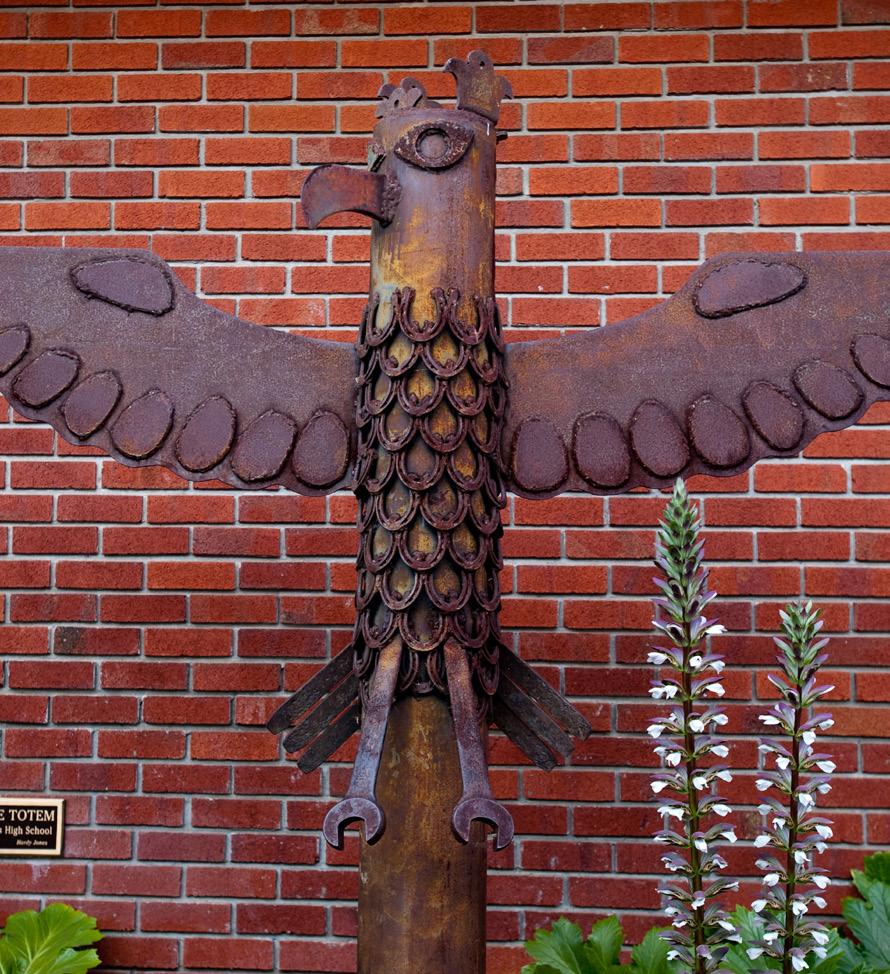
Whether contemporary, irreverent, traditional or something more, sculptures are often the focal points of civic art. Sculptures may commemorate and celebrate history, express civic pride, or be established as culturallydefining showpieces for the city. Sculptures can take on many shapes and sizes and often fit well when created in or alongside gateways, parks, gathering spaces, and community centers. Because communities can celebrate and enhance their civic identity through sculptures, they are especially appropriate in parks and downtown settings.
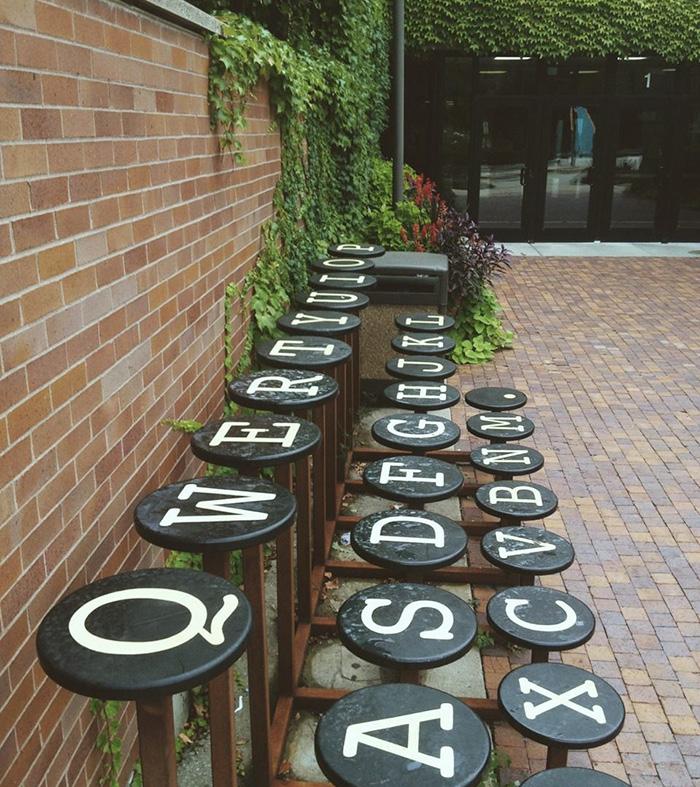
Functional art provides an opportunity for municipalities to explore having artists generate everyday items such as benches, trash cans, light poles, or bollards. Functional elements appear in every public space and provide cities with an opportunity to creatively use funds for art rather than on standard furnishings.

While curating permanent works of art as part of the collection is important, ephemeral works such as murals allow for the exposure of many artists over a short time rather than a few artists over a long time.

While curating permanent works of art as part of the collection is important, ephemeral works such as murals allow for the exposure of many artists over a short period of time rather than a few artists over a long period of time.

Textiles run the gamut from wall hangings to giant masterpieces that visually impact public spaces. This artform can be used to add interest to new spaces or existing spaces within public buildings.


Public performances, while ephemeral, bring the community together through a shared experience. Supporting performers and bringing them into the fold in a meaningful way also works to build a healthy arts and culture ecosystem. In return, performers bring a special something to community events, public spaces, and venues

Art can be long-lasting, or it can be something experienced for a short period of time. Though temporary art is not intended to live for a generation, it can have a lasting impact on a community by creating a sense of surprise and joy in unexpected places. These installations can be created inexpensively but have a large impact, making them ideal for areas such as construction sites, parks, and sidewalks. Temporary artwork’s short lifespan gives energy to the space and drives excitement among the community. These pieces also invite collaboration, be it with local schools or community groups, and provide an opportunity for the artwork to evolve with the community over time.
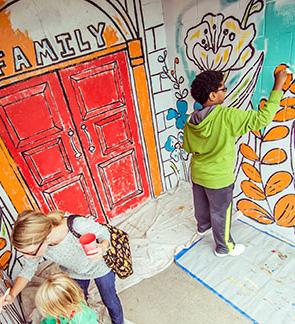
Participatory art is more focused on the creation of an art piece than the other typologies. Specifically, a piece is made by the community to enhance and celebrate its participants. Collaborative art pieces use people to enrich the experience and heighten the feeling of pride and ownership.

Site-specific art is that for which an artist considers the site before anything else. Sitespecific art uses the surroundings to enrich the experience of a place. It can help tell the story of a location, its neighbors or residents, or simply exist to elevate the site.


Woodstock Public Art Program staff collaborates closely with city departments and other project stakeholders to determine the funding sources, objectives, and appropriate locations for public artworks. Staff then develops a comprehensive project summary to be included in the Call to Artists (CTA).

Based on insights gathered from preliminary conversations, Woodstock Public Art Program staff drafts the project scope, outlines eligibility requirements, and prepares the CTA, which typically takes the form of a Request for Qualifications (RFQ). The CTA is presented to the Public Art Commission for review and approval before being published and widely disseminated.
Program staff assembles a panel of arts professionals, community representatives, and project advisors to review artists’ qualifications and select the most suitable artist(s) for each project. The selection process is rigorous and transparent, ensuring that the chosen artist(s) possesses the necessary skills, experience, and vision to create impactful and meaningful public artworks that resonate with the Woodstock community.
Program staff works closely with the selected artwork, including scale models, materials, detailed budget, timelines, and construction documents (shop/structural drawings) that clearly outline fabrication and installation assembly, machining, or manufacturing of

The selected artist(s) engages in independent research and holds regular meetings with Public Art Program staff and constituent neighborhoods/communities to gain a deep understanding of the project’s construction timelines, program objectives, and community priorities and values. This collaborative approach fosters a sense of ownership and ensures the artwork reflects Woodstock’s unique character and identity.
In an ongoing process, the artist collaborates with program staff and the city department to coordinate the delivery, installation, and inspection of the completed artwork at the specified site. Staff and the artist review the artwork maintenance plan, undergo conservation training when applicable, and finalize the transfer of title. Prior to the community celebration, program staff completes the accessioning process, conducts a final inspection, receives the artwork title, documents the maintenance/conservation plan, and oversees the dedication ceremony.
The Woodstock Public Art Program shall be administered by the City of Woodstock’s Economic Development Department.
In order to steward the Woodstock Public Art Program and build a world-class public art collection, an ad hoc Public Art Committee should be formalized into a Public Art Commission. The Public Art Commission should function principally in an advisory capacity to staff in any matter pertaining to public art and support staff in:
• Establishing criteria and eligibility standards for applicants of projects
• Establishing criteria for awarding projects
• Evaluating proposed donations of public art
• Collection maintenance
• Evaluating removal of artwork from public display
To execute the program, it will be necessary to have significant staff time devoted to its development. The Public Art Coordinator will manage the Public Art Program. This position will ensure the program is managed properly and that each project is executed with the city’s best interests in mind. The position could be an internal position or a contract position with an outside consultant.
The Public Art Coordinator has the following responsibilities:
• Developing and implementing an annual Public Art Work Plan in coordination with the Public Art Commission and appropriate city departments and representatives
• Overseeing the administration of the commissioning of new works of public art, including, but not limited to:
» Project planning — developing scopes of work and project budgets, coordinating with the project manager and project architect, and identifying community partners when necessary

» Management of the artist selection process — developing and distributing RFQs and RFPs, staffing the artist selection committees, and conducting artist workshops
» Project implementation — developing contracts, getting necessary approval, coordinating with the project manager, reviewing preliminary and final designs, and monitoring artist progress and compliance with the project contact
» Documentation — keeping records of contracts, photographs, construction drawings, maintenance manuals, and meetings
» Community education — assisting in garnering publicity for projects, facilitating public meetings, and developing educational materials
• Overseeing the work of project consultants
• Informing community partners of ongoing project work and coordinating with them as necessary
• Ensuring adequate insurance and liability protection is secured by artists, contractors, and the city prior to installation.
• Coordinating any necessary management agreements through artists, contractors, community groups, private property owners, and the city as needed
• Monitoring private development projects to assist private developers in including public art in their developments and guiding them, when requested, through the process of placing public art within their projects
• Identifying collaborations and sources of funds
• Overseeing a comprehensive conservation survey of the Public Art Collection and ensuring all necessary repairs are conducted
• Serving as a liaison between the city, artists, and/or business organizations relative to the Public Arts Program
• Supporting the Public Art Commission
• All other duties as assigned
The Collection Management Policy is intended to maintain the value of the city’s Permanent Collection and guard against inappropriate disposal of its pieces. Adoption of a Collection Management Policy would preserve the value and legacy of the current collection and account for the maintenance of the future collection. Sound collection management practices include routine documentation, monitoring, and maintenance.
A Collection Management Policy addresses and establishes the following:
• Standards and processes for acquiring new pieces through solicitation, purchase, commission, donation, and the acceptance of memorial gifts
• Policies for the acquisition and handling of temporary public art
• Standards for maintenance, relocation, and deaccessioning of any of the pieces in the collection
• Direction for inspecting and surveying the collection, and working with future artists to establish maintenance plans for any commissioned work
• Procedures for individuals and organizations who wish to donate artwork to the city
A designated staff member should administer or oversee the following tasks:
• Regularly checking objects in the collection for insurance, maintenance, and evaluation purposes

• Regular collection inventory/database upkeep
• Routine maintenance and repairs or restoration, in accordance with the highest standards of professional conservation practice
• Planning for future development of the collection
• Advocating for collection maintenance funding, when appropriate
Art can be long-lasting, or it can be something experienced for a short period of time. Though temporary art is not intended to live for a generation, it can have a lasting impact on a community by creating a sense of surprise and joy in unexpected places. Some ideal locations for temporary installations include construction sites, sidewalks, alleyways, parks, and temporarily empty spaces and storefronts.
Temporary art can be done inexpensively and easily, provide opportunity for additional artist engagement, and it can be a small investment for a huge impact. In whatever form, its short lifespan gives energy to the space and drives excitement among the community. Temporary art invites collaboration, be it with local schools or community groups, and creates opportunity for the artwork to evolve with the community over time.
Temporary Public Art should be administered in accordance with the Collections Management Plan.
This policy, as part of the Collection Management Plan, establishes the procedures to maintain the city’s current and future art collection. Direction for surveying the collection, working with future artists to establish a maintenance plan for any commissioned work, and inspection guidelines are included.
The Maintenance Plan will enable the city to:
• Evaluate the quality and sustainability of the proposed or existing public artwork
• Establish maintenance requirements, assign schedules, and identify potential costs
• Determine if it should accept or decline the design proposal and/ or public artwork
To produce a Maintenance Plan, artists should render an opinion on the following:
• Durability
• Type and integrity of materials
• Construction/fabrication technique
• Internal supports, anchoring and joining, and footings
• Landscaping
• Vulnerable and delicate elements
• Drainage of artwork
• Potentially dangerous elements
• Security
• Location
• Environment
• Whether the design encourages/discourages interaction
• Effects of skateboarding, graffiti, and any other potentially damaging activities
The Maintenance Plan will include:
• A record of the artist’s intentions for the work of art
• Recommendations to mitigate potential problems discovered during the examination
• Notes about how the artist would like the work of art to age
• An itemization of long-range considerations and care, highlighting maintenance and the anticipated needs for periodic conservation treatment or repairs
• Identification of the lifespan of the artwork and a prognosis of its durability in consideration of that lifespan
Artwork lifespan will be:
• Temporary: 0–2 years
• Short Term: 2–10 years
• Medium-Term: 10–25 years
• Long-Term: 25+ years
The artwork may also be identified as site-integrated, or part of a site and/ or its architecture, in which case it will be considered to have a Long-Term lifespan.
Individuals or groups may desire to play a more active role in the development of the City of Woodstock’s public art landscape. One way in which to do so would be through the donation of specific works of art or the donations of funds to commission art owned by the City of Woodstock. This policy establishes the donation process for artworks not commissioned by the city, or for individuals or organizations who want or wish to donate artwork to the city. These donations may be considered on a case-by-case basis, and requests for consideration shall be made to the Public Art Staff Committee. Each proposed donation must come with a plan to fund and deliver ongoing maintenance, or the resolution accepting the public art must identify how maintenance of it will be funded. Donation requirements, responsibilities of the donating party, and the process for donating a piece of public art are outlined in this policy.
There are many options for funding a municipal Public Art Program, and funding need not only come from a single source. The following section outlines several potential funding mechanisms with the ability to achieve the vision set forth in this plan.
The general fund can provide funding on an annual basis with the intention of identifying projects at a later date or allocated with specific projects in mind. Whichever route is determined to be the best fit in a given year should be allocated under the advisement of City Council.
Percent for Art Ordinances
A Percent for Art in Capital Improvement Projects and a Percent for Art in Private Development will ensure long-term funding for the Public Art Program. These strategies will yield momentum for the Public Art Program, building energy and support for future investment. These funding streams should be evaluated to determine if any alterations to the ordinance should be made after five years.
Percent for Art in Woodstock Capital Improvement Projects (CIP)
A Percent for Art ordinance would encumber a percentage (2% is best practice) of City Capital Improvement Projects (CIP) per year for the commissioning of public artworks. The funding could go towards artworks sited in, on, or adjacent to the project being constructed, or may be redirected to a fund that can then be directed to priority throughout the city. This ordinance could guarantee a funding stream for

public art projects well into the future. The policy also guarantees that public art projects will be planned each year, as long as CIPs are underway and municipal construction continues.
All capital construction projects qualify except the following:
• Regular road maintenance
• Underground infrastructure and underground utility projects with no above-ground components other than roads. Projects with underground infrastructure, including utility projects, should be included when there are visual elements of the project above-ground. The total budget of the project should include all underground components.
Types of potential Capital Improvement Projects to include public art within:
• New roads
• Streetscape Projects
• Fire and Police Stations
• Parks & Trails
• City Facilities
Percent for Art in Private Development
There is the potential for Woodstock to implement a percent for art in private development.
• Child care centers
• Individually developed single family homes
• Subdivisions with 4 or fewer dwelling units
• Commercial and industrial projects with a building valuation of $500,000 or less
• Multifamily residential projects with a building valuation of $1,500,000 or less
• Any Affordable Unit development projects
• Mechanical, plumbing, and electrical system upgrades; structural or seismic upgrades; and modifications for disabled access, unless
occurring in conjunction with alternations of a building or an aboveground structure
• Building remodeling, building additions, and related activities where the building valuation is not increased by more than 50 percent
• Remodeling, repair, or reconstruction of structures that have been damaged by fire, flood, wind, earthquake, or other natural cause
• Nonprofit [501(c)(3)] social service institution construction projects
This would not be an impact fee; rather, this is a substitute for development standards. The public art requirement for any single project shall not exceed $200,000. All applicable private development must elect one of the following assessment methods, submit a completed art requirement application, and provide a copy of the total construction costs, as indicated on the construction contract(s), within 90 days of the issuance of the first building permit or site work permit for a subdivision plat for any portion of the project:
A. Submit documentation evidencing the escrow of funds for an art feature valued in an amount not less than 2% of the total construction costs.
B. Submit an application for approval of the art feature to the Commission, who will assist in routing the applicant through the city’s approval process.
Option 2: Contribute to the Woodstock Public Art Acquisition Fund
A. Contribute an amount equal to 80% of the 2% of the total construction costs for deposit to the Woodstock Public Art Acquisition Fund.
The public art funds may be spent for:
• Calls for Entry, RFQ’s/RFP’s, concept designs, maquettes, juror stipends, and other costs related to competitions and commissions
• Artist fees including travel stipends and expenses related to travel
• Artwork fabrication and installation
• Acquisition of existing works of art
• Relocation of existing or commissioned works of art
• Required permits and insurance during the fabrication and installation of the artwork
• Informational/promotional materials and public events directly related to the artwork
• Artwork appraisal
• Art-related community events
• Staffing and services of an Arts Administrator
• Curators and contracted services
The public art funds may not be spent for:
• Mass-produced work, with the exception of limited editions controlled by the artist
• Professional graphics, unless designed or executed by an artist or used in the development of collateral material
• Decorative, ornamental, or functional elements that are designed by a project’s architect or other designer
• Routine maintenance exceeding more than 10% of the annual budget
• Purchase of existing works of art outside of the selection process

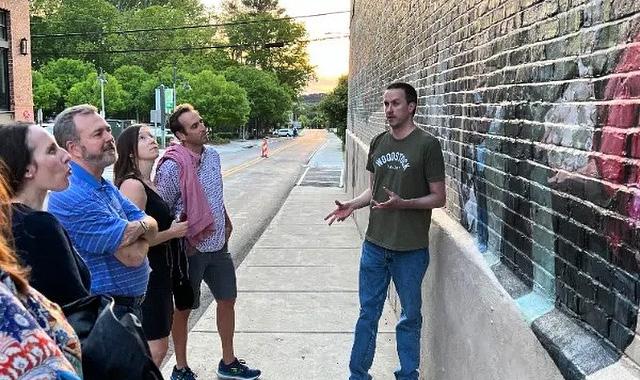


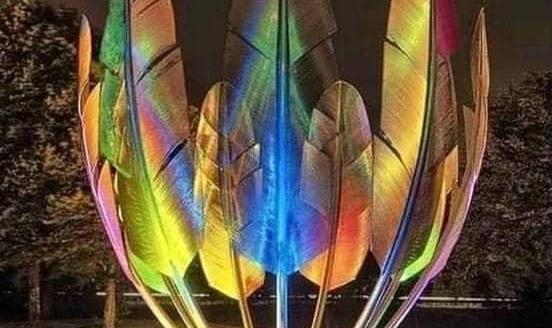
Known for its award-winning downtown, Woodstock has the opportunity to further strengthen its sense of place through a series of public art interventions on both public and private properties in downtown spaces.
The city should develop a mural grant program that provides support for up to 75% of the cost for private property owners to place murals on their structures.
The city should consider art as a wayfinding element within and on the parking garages downtown, whether on each elevator bay, on supportive peers, or on the walls of each level.
Utility poles also present an interesting opportunity for low-cost, temporary artwork that could support local artist participation in the Public Art Program.
Downtown provides ample opportunity for an iconic sculpture that will be unique to the pedestrian experience in Woodstock.
• Parking Garages
• Alleyways
• Utility Poles & Boxes
• Public and Private Plazas & Buildings
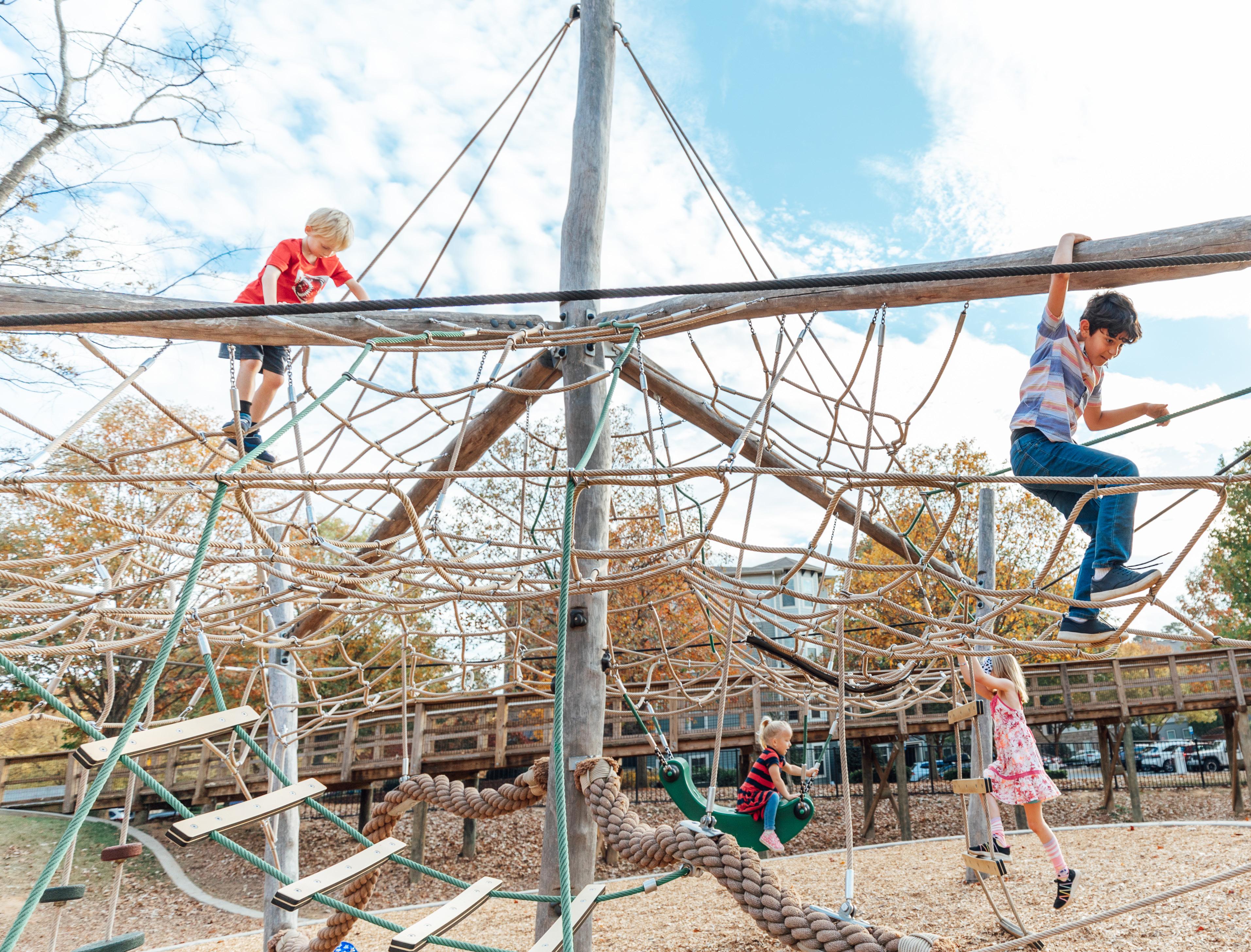
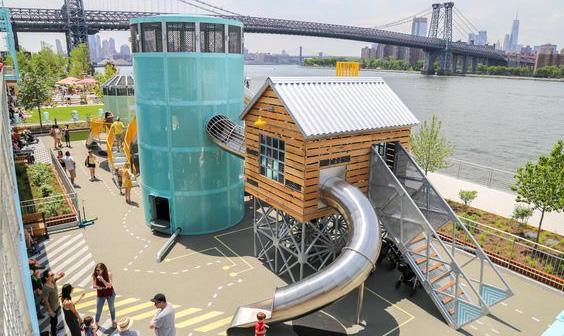
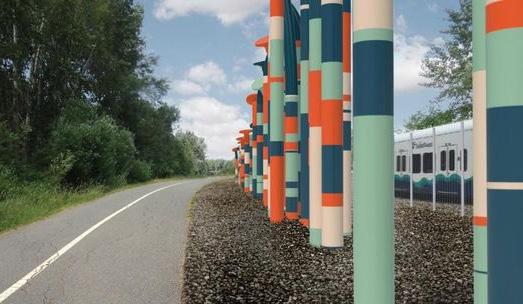

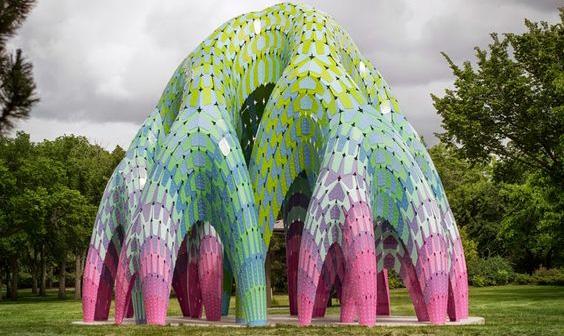
Underscored by survey results and community input, parks and the natural environment are well-loved and cherished by Woodstocks’ residents and visitors. Public art situated within parks and along trails will facilitate a stronger connection between the natural environment and the people of Woodstock.
Sites such as the proposed 100-Acre Wood present the opportunity for the City of Woodstock to collaborate with artists to create truly one-of-kind experiences centered around nature and play. Artistdesigned playgrounds bring elements of surprise and delight to traditional, functional structures and spaces.
Trailheads are scattered throughout the city and are the connective tissue between neighborhoods and commercial centers. Art should be placed at the trailheads to pull people onto the trails, enhancing their overall experience.
• The 100-Acre Wood site
• All city-owned parks
• Trails and Trailheads, such as Towne Lake Parkway and Buckhead Crossing

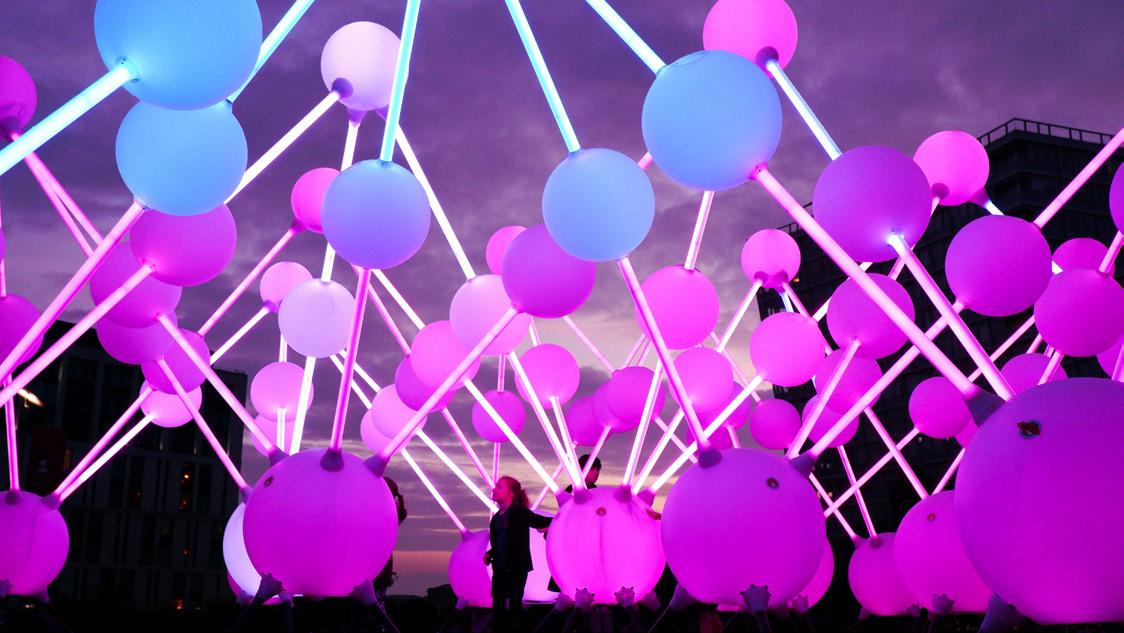
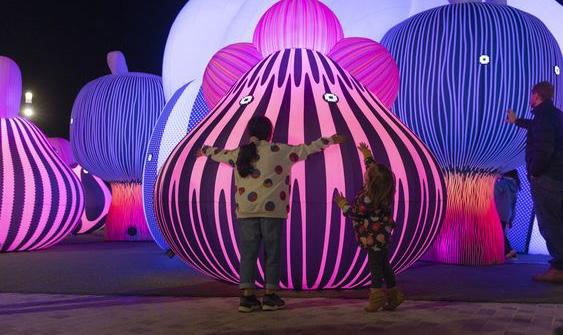
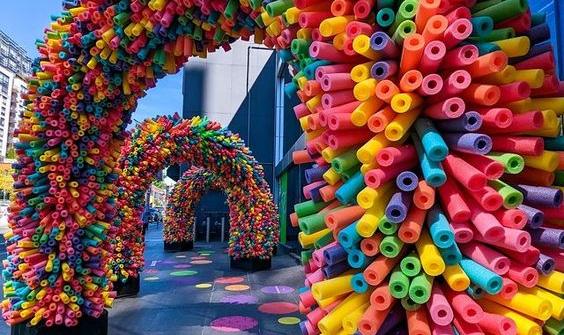

By utilizing existing and planned event sites to host both temporary and permanent pieces of public art, Woodstock can cement its creative identity by creating new opportunities for residents and visitors to interact with public art as a shared public experience.
Woodstock is known for its well-attended events—adding events that focus on public art would provide unique experiences in the North Atlanta area.
Temporary installations provide the opportunity for Woodstock to create new events centered around art or add a new experience to existing, well-loved events.
• Festivals
• Farmer’s Markets
• Music in the Park Series
• New Art-centric Events

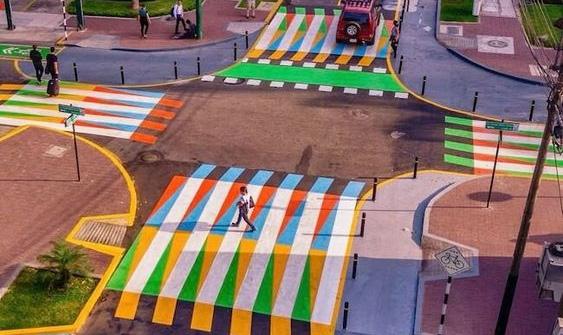
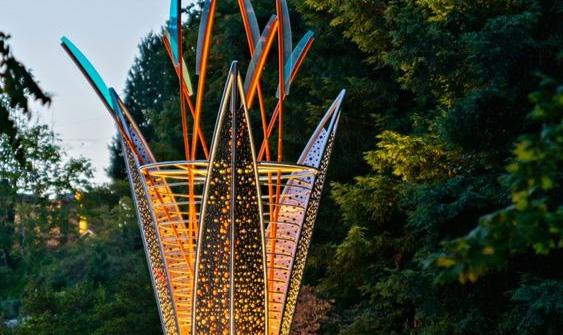
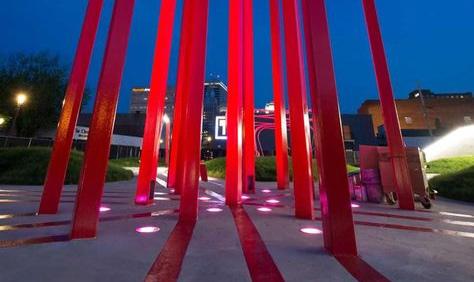
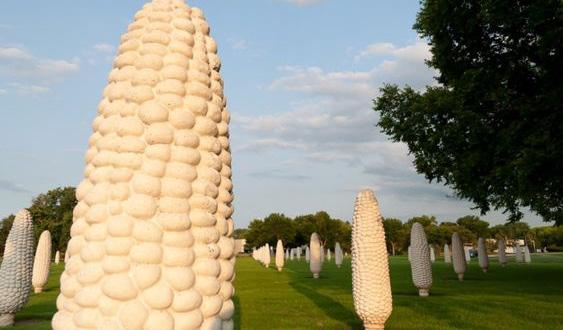
Public art situated along corridors and at gateways is a more direct approach to emphasizing city identity and establishing to passersby that there is more to explore inside the city. These types of public art pieces will allow Woodstock to capture a new audience and create a stronger sense of place.
Artist-designed crosswalks provide greater visibility to traffic and naturally encourage vigilance and caution when moving through them, increasing safety and improving the pedestrian experience.
Artist-designed utility wraps should be placed at major intersections providing visually pleasing infrastructure. These should be digital pieces of art that can be scaled to fit the boxes.
Gateways into the city are excellent and impactful locations for public art that can act as a wayfinding mechanism. Artists could design unique elements for each gateway, or an artist could design a piece that appears at each gateway.
Unused green space provides ample opportunity for sculpture.
Landscaped medians provide an opportunity for art placement on pedestrian-friendly roads and an opportunity for traffic calming principals to be applied using art instead of landscape only.
• Major Roadways & Roundabouts
• Greenstrips
• Utility Boxes & Poles

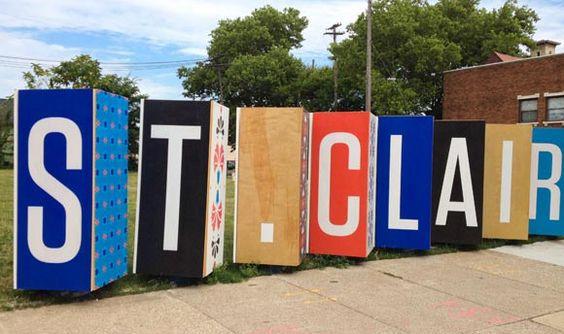
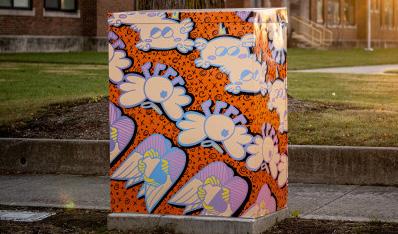
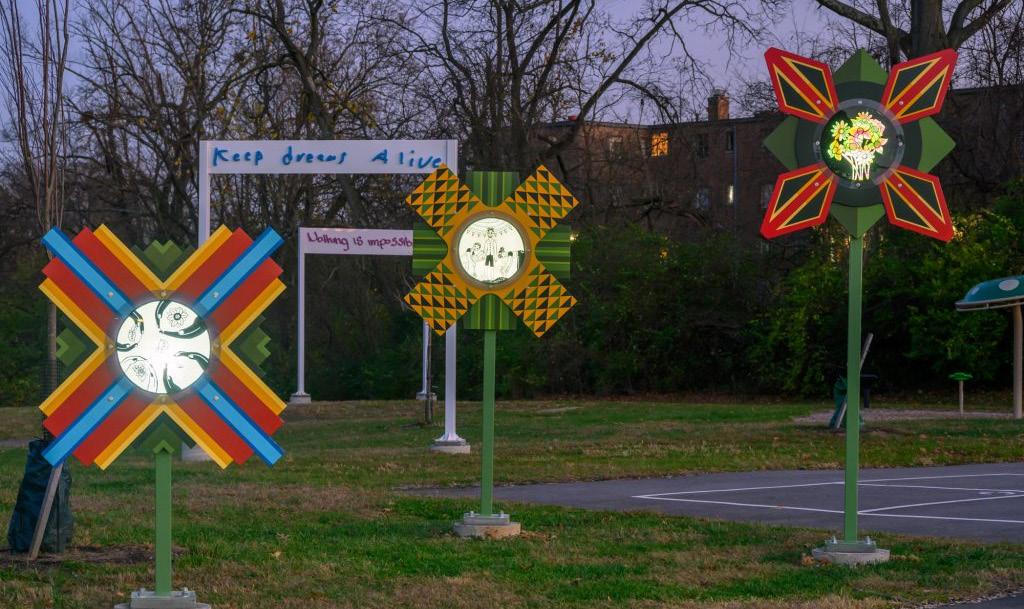
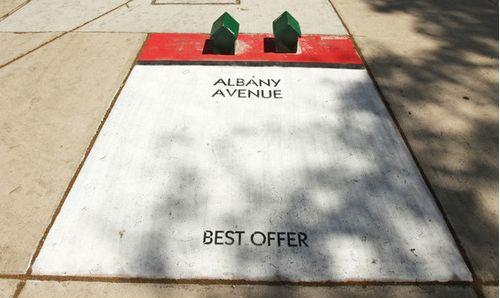
Thinking beyond downtown, public art can create stronger neighborhoods and allow for more diversity and exploration of themes and content by allowing neighborhood residents to weigh in on the creation of their pieces. Woodstock can facilitate public art projects that speak to those distinct neighborhood personalities.
Artists can be great partners for beautifying neighborhoods and creating a sense of place with lowercost solutions, such as movable art pieces, wayfinding, and small-scale pieces.
Artist-designed utility wraps should be utilized to beautify neighborhoods and subtly address unsightly infrastructure. These should be digital pieces of art that can be scaled to fit the boxes.
To beautify neighborhoods where private property ownership and HOA regulations can provide barriers, the City of Woodstock should explore place art in the public right-of-way for neighbors to enjoy.
• Public Right-of-Way
• Utility Boxes & Poles
• The Entrances of Neighborhoods

The following section provides example public art and creative placemaking strategies for each of the character areas outlined in the Woodstock Comprehensive Plan. This section is intended to provide further inspiration and direction for public art that complements and aligns strategically with the City of Woodstock’s goals and collective vision for the future.
Alongside each palette is a live-work-play indicator that informs where there are opportunities to impact those that work, live, or vist Woodstock. It can also be used as a reminder to selection panels who is the intended audience when selecting artwork for each character area.
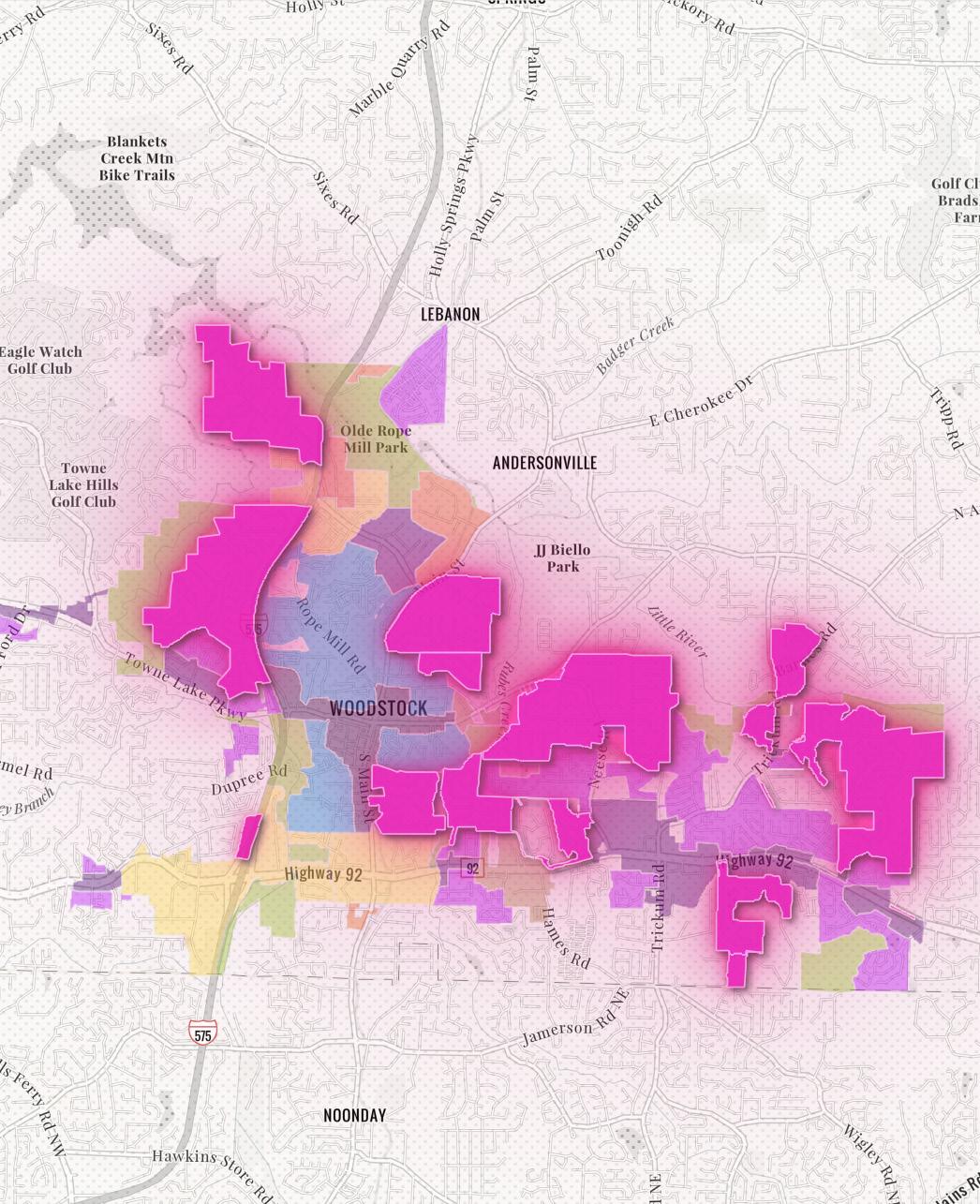


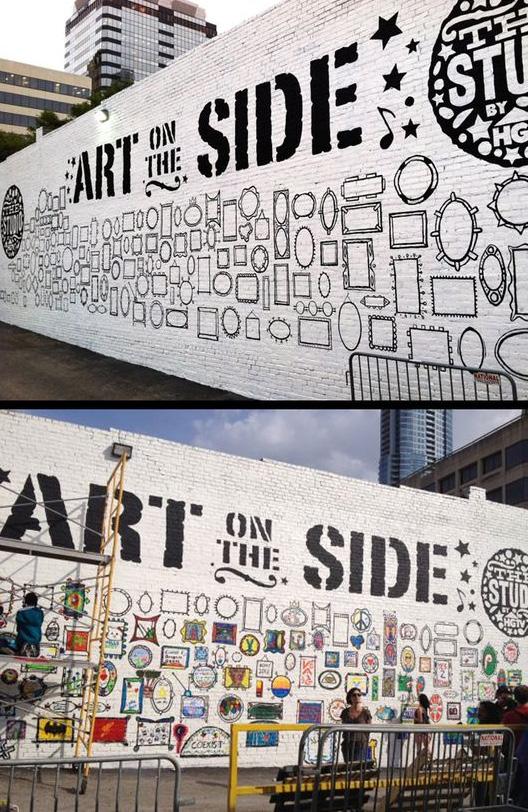
Woodstock’s Suburban Living areas are characterized by large lots, detached housing, and interconnected street networks, and provide a unique canvas for public art interventions aiming to enhance the residential landscape and foster a strong sense of community identity.
By strategically integrating public art into this character area, Woodstock can create a more vibrant, engaging, and aesthetically pleasing suburban atmosphere that contributes to a stronger sense of community, promotes well-being, and enhances residents’ quality of life.

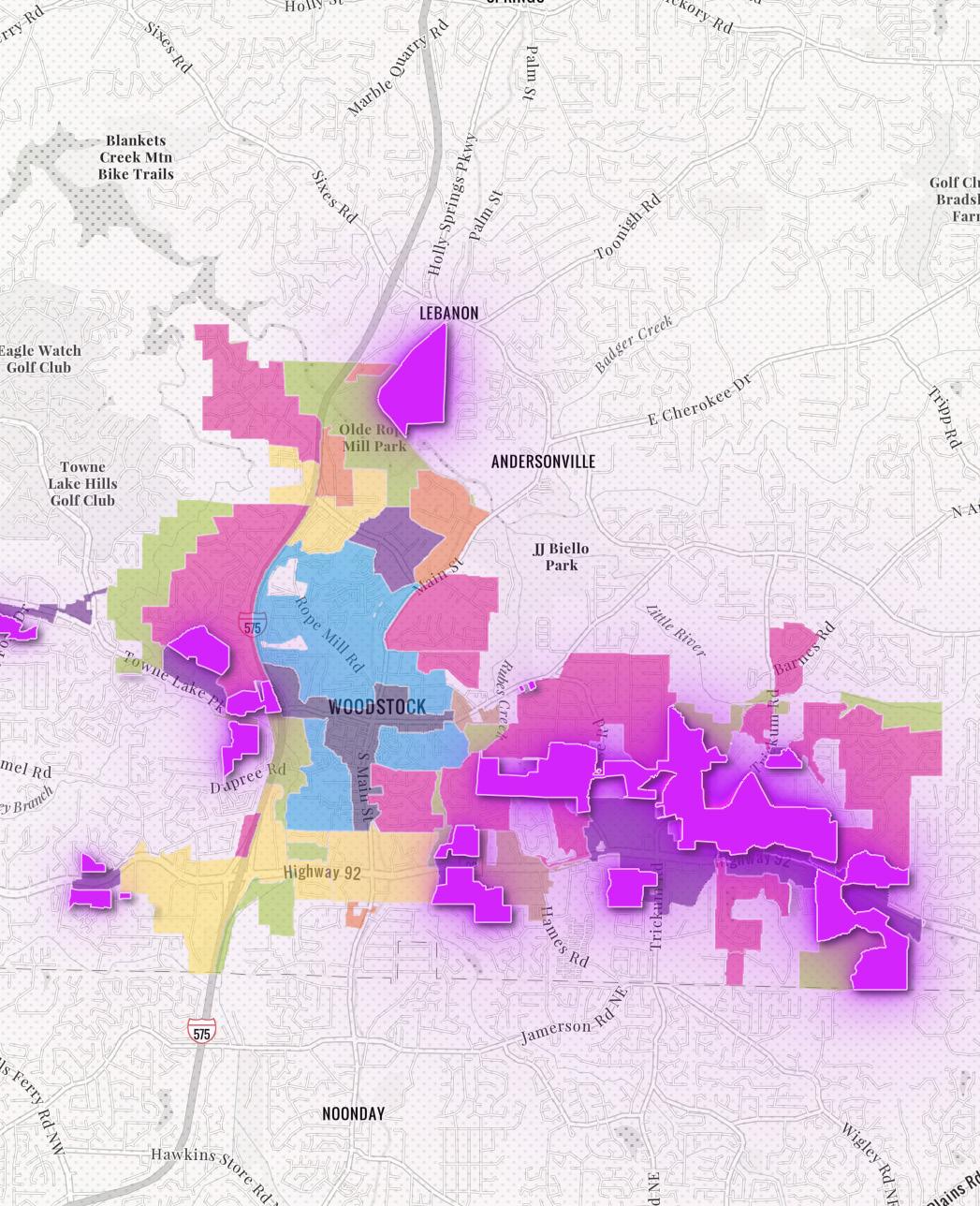
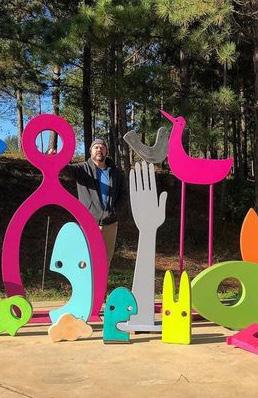

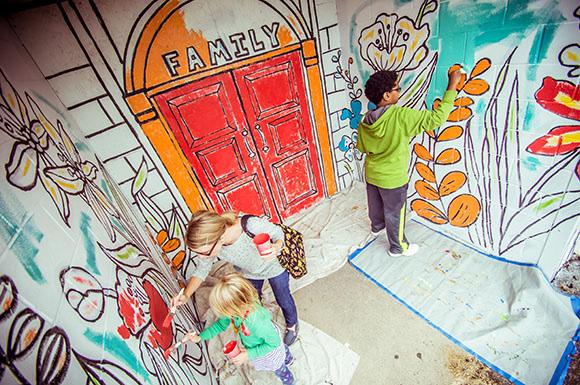
Woodstock’s Neighborhood Living areas, which are characterized by traditional residential developments with close proximity to commercial and mixed-use spaces, provide ample opportunity for public art to enhance community identity, foster social connection, and contribute to a vibrant living experience.
Public art scattered throughout neighborhood spaces can spark curiosity and invite playful engagement, adding a touch of wonder and delight to the everyday experience.



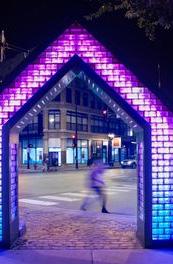
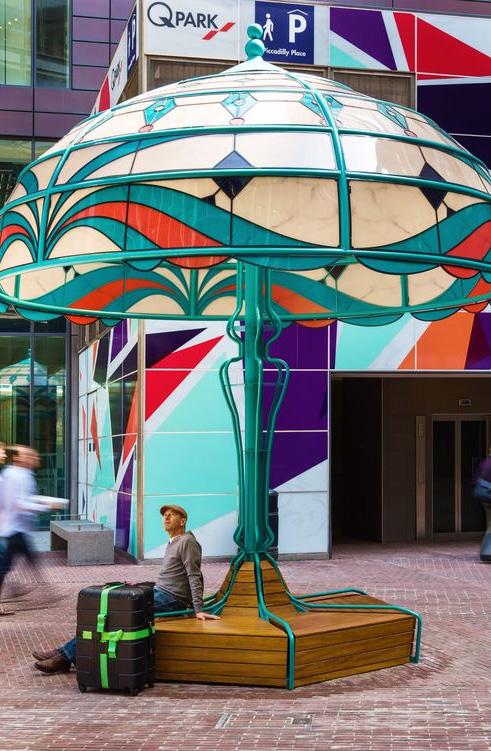
The City of Woodstock envisions its Community Village Centers as vibrant hubs offering essential retail, dining, and services to surrounding neighborhoods. Designed with a “village-like approach” prioritizing aesthetics and walkability, these centers provide a prime opportunity for public art to flourish.
Public art commissioned in these spaces has to opportunity to transform the public experience from the everyday into something remarkable.



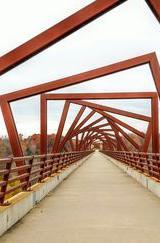


Woodstock’s Natural Preserves offer a unique opportunity for public art to enhance the connection between people and nature. With the focus of this character area being centered around recreation and nature, public art interventions have the potential to promote playfulness and deepen the visitor experience.
By thoughtfully integrating public art into this character area, Woodstock can promote environmental awareness, inspire a sense of stewardship, and contribute to the overall well-being of the community.
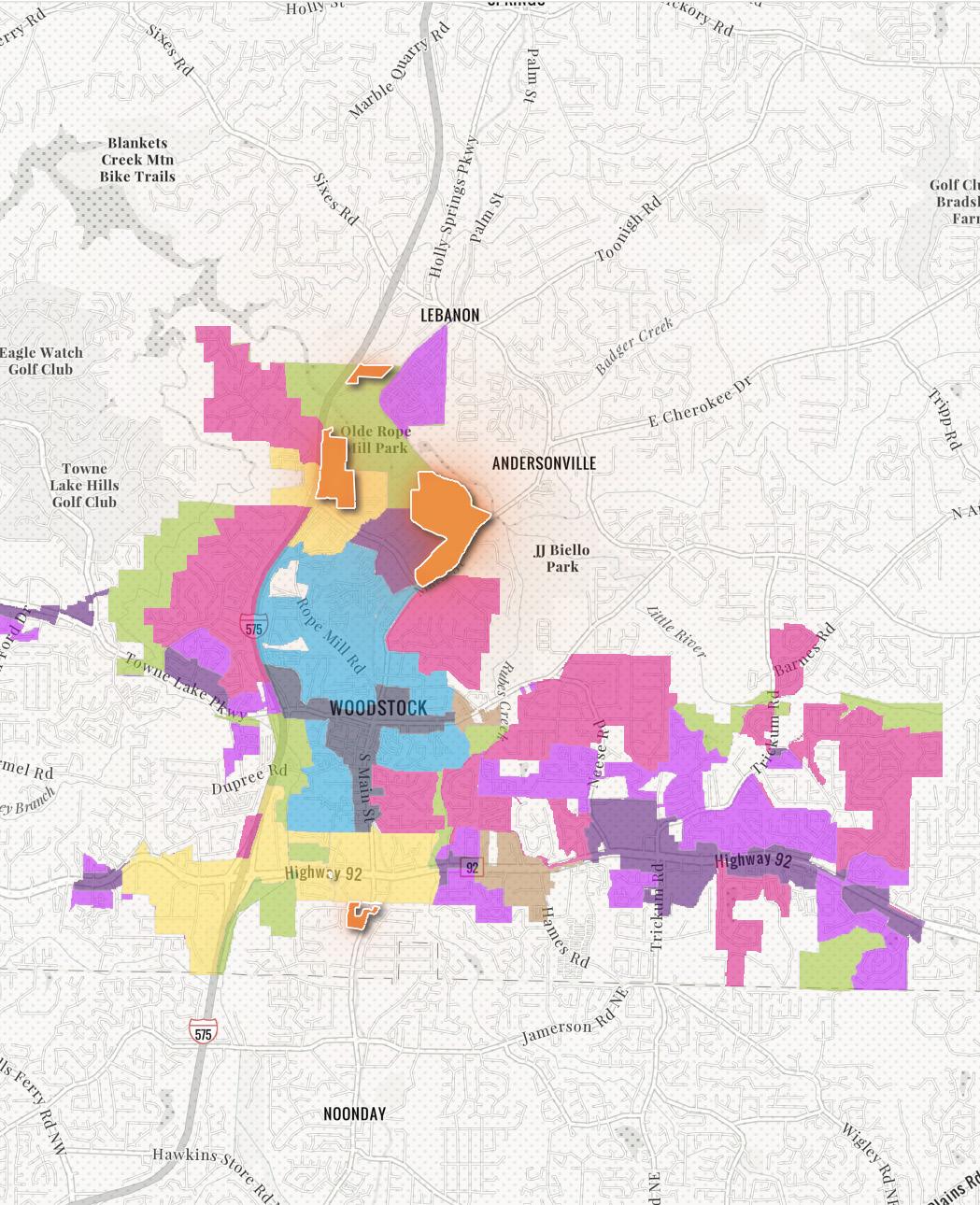



While primarily focused on commercial and industrial uses, Woodstock’s Workplace Centers character areas provide a unique utility to the wider community. While these are typically overlooked for public art installations, they can still serve as dynamic canvases for artistic expression and enhance the overall aesthetic of the city.
Public art installations integrated into these spaces can create inviting and functional areas for employees to relax and connect with their surroundings.


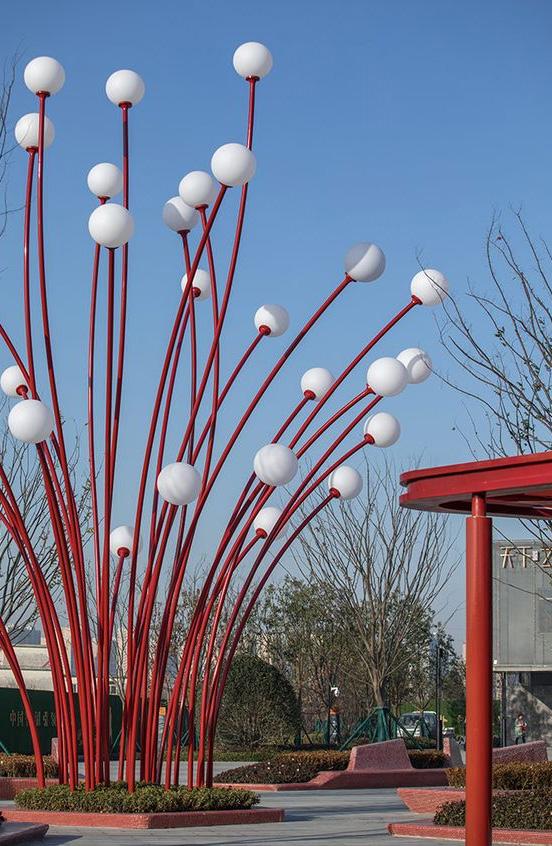
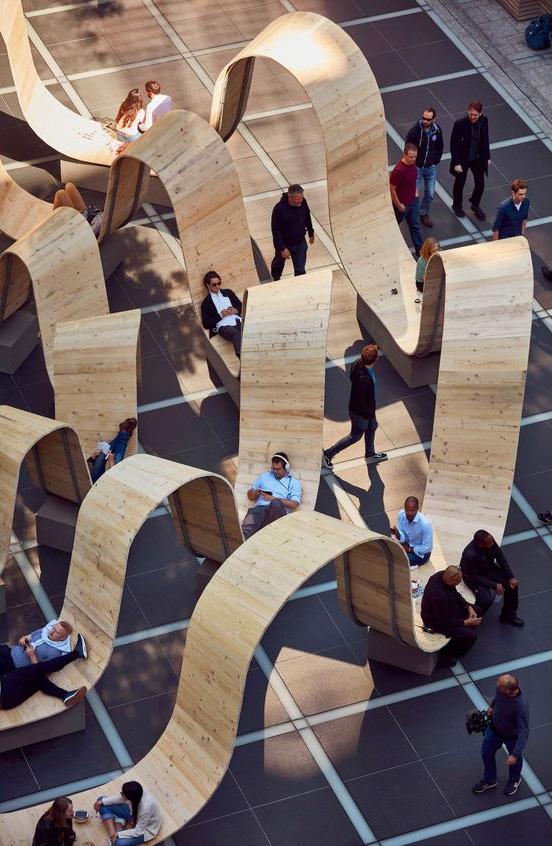

The City of Woodstock’s Regional Activity Centers draw large numbers of those that live, work, and visit Woodstock. Integrating public art into this dynamic mix of major retail, office, and hospitality spaces such as hotels to can help create vibrant hubs for commerce, culture, and community engagement.

Public art can play a crucial role in shaping this evolving center. Digital art displays in central locations and public spaces can provide real-time information while also promoting the work of local artists and upcoming events.





Woodstock’s Employment Villages, strategically located near major transportation facilities and sometimes bordering residential areas, provide a unique opportunity for public art to foster creativity, community, and economic vitality. These areas, designed to accommodate smaller independent businesses, small services, and incubator spaces, have a intangible identity that can be captured and represented in the built environment through public art.
By incorporating public art into its Employment Villages, Woodstock can create more vibrant, inviting, and aesthetically pleasing spaces for businesses, employees, and residents. This can contribute to a more positive work environment, attract talent, and foster a stronger sense of community within these key economic hubs.





Woodstock’s Urban Village, a transitional area bridging the downtown and surrounding neighborhoods, is an area where prioritizing public art can build the connective thread to the urban core. With its moderate-density housing and focus on serving residents’ daily needs, this area provides a platform for artistic expression that can enhance the quality of life, foster a sense of community, and contribute to the overall character of the city.
Imagine walking through the Urban Village, encountering captivating murals on building facades and fences, transforming ordinary structures into vibrant storytelling canvases. Interactive sculptures scattered throughout parks and playgrounds can spark curiosity and invite playful engagement, adding a touch of wonder and delight to everyday experiences.

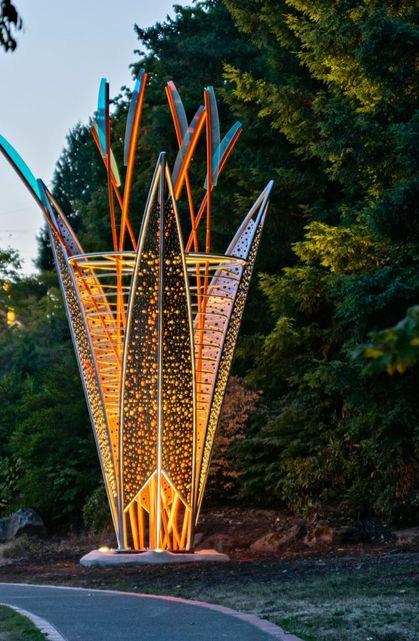



Woodstock’s revitalized urban core, characterized by a mix of historic buildings, new commercial and residential developments, and diverse public spaces, is a priority area for public art. As the city grows and density increases, public art can help define its character and identity, particularly in this character area.
Beyond visual enhancements, public art can also play a crucial role in strengthening the social fabric of Woodstock’s downtown core. Collaborative art projects involving local artists, residents, and businesses can facilitate interaction, build bridges, and create a sense of shared ownership of this central district, revealing to the public the underlying character and identity of Woodstock itself.


The following section provides an example pricing heirarchy for artwork showcased throughout the plan. It should be noted that price varies based on current market conditions, cost of materials, artist selected, site for installation, and environmental conditions and constraints.





